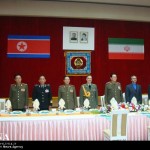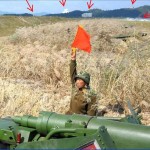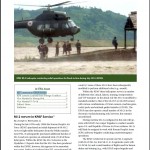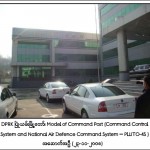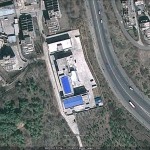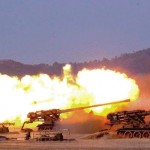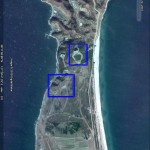UPDATE 4: Photos of the aspiring leader have been made public. Daylife.com has all of them here.
UPDATE 3: Just for fun…there appears to be at least one other “Kim Jong-un” in North Korea. It will be interesting to see if he has to change his name (if he is still alive)! Here is a KCNA story from April 23, 1997:
Press review
Pyongyang, April 23 (KCNA) — Papers here today frontpage reports that Secretary Kim Jong Il sent thanks and gifts to workteam members of the no. 7 excavator operating in Kumsan pit in Ryongyang mine for their collective innovation and thanks to servicemen and their families for setting examples in army-people relations. Reported in the press is the news that a monument to on-site guidance of Secretary Kim Jong Il, Supreme Commander of the Korean People’s Army, was erected at the unit that defends Cho Islet, a forward military post on the West Sea of Korea. Rodong Sinmun carries a letter sent to Secretary Kim Jong Il by participants in the meeting of senior officials of progressive parties of different countries held in Moscow to mark the 85th birth anniversary of President Kim Il Sung as well as a statement adopted at the meeting. Minju Joson comes out with an article headlined “Our General always stands on Height 1211”. Conspicuous in Rodong Sinmun is an article titled “devotedly defending headquarters of revolution is foremost mission of people’s army”. The paper gives nearly one whole page to the lyric epic “Supreme Commander and his vanguard soldiers” which is dedicated to heroic soldiers. The Swedish Government decided to take a humanitarian measure for Korea, the press reports. Rodong Sinmun runs an article “Korean-style socialism is the best”, written by Kim Jong Un, who came over to the northern half of Korea while serving in the south Korean puppet army. Papers comment on the disclosure of Kim Young Sam’s bid to conceal the truth as regards the “investigation” into the Hanbo incident. An article of Rodong Sinmun says that the south Korea-stationed U.S. forces’ possession of depleted uranium bullets proves that their moves for war reached an extremely grave phase. Seen in Minju Joson is an article on the triangular military tieup of the U.S. and Japanese reactionaries and the south Korean puppets.
UPDATE 2: Kim Jong-un was also named to the Central Committee of the Korean Worker’s Party. According to KCNA:
Members and Alternate Members of WPK Central Committee
Pyongyang, September 28 (KCNA) — The following are members of the WPK Central Committee: Kim Jong Il, Kang Nung Su, Kang Tong Yun, Kang Sok Ju, Kang Phyo Yong, Kang Yang Mo, Ko Pyong Hyon, Kim Kuk Thae, Kim Kyong Hui, Kim Kyong Ok, Kim Ki Nam, Kim Ki Ryong, Kim Rak Hui, Kim Myong Guk, Kim Pyong Ryul, Kim Pyong Ho, Kim Song Dok, Kim Song Chol, Kim Jong Gak, Kim Jong Suk, Kim Jong Un, …
Mike has a good summary here.
UPDATE 1: Kim Jong-un has been named to the KWP Central Military Comission. Kim Kyong-hui has joined th According to Bloomberg:
Kim Jong Un was elected one of two Central Military Commission vice chairmen at a Worker’s Party of Korea meeting yesterday, a day after he was made a four-star general, the official Korean Central News Agency said. He also joined the party’s Central Committee, though not the more elite Politburo, at a meeting yesterday. His father’s sister, Kim Kyong Hui, was given several high-ranking posts, including politburo membership, KCNA reported.
The Kim family’s tightening grip on the military and party hierarchy underscores the challenge of transferring power to a son who had never before been mentioned in a KCNA dispatch. Kim Jong Un faces an increasingly disgruntled public in an economy squeezed by United Nations sanctions targeted at its weapons programs and a bungled currency revaluation.
“Even Kim Jong Il must be wary of public criticism should his son fail to improve economic conditions,” Paik Hak Soon, director of inter-Korean relations at the Seongnam, South Korea- based Sejong Institute, said before the commission appointment. “Domestic political stability will be Kim Jong Un’s key focus.”
Kim Jong Il, 68, was re-elected as party chief, general secretary and chairman of the military commission, KCNA said.
…
China’s President Hu Jintao congratulated Kim Jong Il on his re-election, pledging to strengthen ties with his country’s communist neighbor “to a higher level,” the state-run Xinhua News Agency reported today, without mentioning the son. Kim Jong Il made an unprecedented two trips to China this year, prompting speculation he was seeking endorsement of the power transfer from his nation’s main political and economic ally.
Here is the original KCNA story:
Central Military Commission Organized
Pyongyang, September 28 (KCNA) — The Central Military Commission of the Workers’ Party of Korea is as follows:
Chairman Kim Jong Il, Vice-Chairmen Kim Jong Un and Ri Yong Ho and Members Kim Yong Chun, Kim Jong Gak, Kim Myong Guk, Kim Kyong Ok, Kim Won Hong, Jong Myong Do, Ri Pyong Chol, Choe Pu Il, Kim Yong Chol, Yun Jong Rin, Ju Kyu Chang, Choe Sang Ryo, Choe Kyong Song, U Tong Chuk, Choe Ryong Hae and Jang Song Thaek.
ORIGINAL POST: Kim Jong-un and Kim Kyong Hui named 4-star generals in KPA. According to Yonhap:
North Korean leader Kim Jong-il has made his third son a military general in the clearest signal yet that Kim Jong-un is on track to becoming the next leader of the nuclear-armed communist state.
The promotion was announced early Tuesday through the official Korean Central News Agency (KCNA), just hours before North Korea was to hold its biggest political convention in three decades.
At the conference drawing top Workers’ Party delegates from across the nation, Kim Jong-un, whose name has never been mentioned in public and believed to be no older than 28, could be given other political posts, including one with the Politburo.
The KCNA report said Kim Kyoung-hui, the 64-year-old sister of Kim Jong-il, has also been promoted to a four-star general along with Choe Ryong-hae, a long-time aide to the Kim dynasty.
Kim Kyoung-hui, who oversees the country’s light industries, has recently emerged as a possible caretaker for a hereditary power transfer because Kim Jong-un lacks experience and support.
Her name was mentioned before Kim Jong-un’s in the KCNA dispatch.
Kim Jong-il, 68, is widely believed to have suffered a stroke in the summer of 2008 and since tried to make his third son his successor in what could be the communist world’s first back-to-back father-to-son power transfer. Kim took over the regime when his father and North Korean founder Kim Il-sung died in 1994.
Kim Jong-il officially became successor to his father in a Workers’ Party gathering in 1980. In a directive numbered 0051, Kim named a total of 39 generals on Monday, the KCNA said. Six of them, including Kim Jong-un and Kim Kyoung-hui, were four-star generals.
“The appointment clears the way for Kim Jong-un to forge deeper ties with power elites,” a South Korean Unification Ministry official said on the condition of anonymity.
U.S. Assistant Secretary of State Kurt Campbell said in a briefing in New York that his country is “watching developments in North Korea carefully.”
“North Korea has now made it official,” Yang Moo-jin, a professor at the University of North Korean Studies in Seoul, said. “It is certain that Kim Jong-un will be named to a high-level Workers’ Party post in the upcoming convention.”
The KCNA said Kim Jong-il “firmly believes that the commanding members of the People’s Army will continue to support the leadership of the party and complete the revolutionary exploit that was first begun in Mt. Paekdu,” which symbolizes the Kim dynasty.
In a separate dispatch, the KCNA said Ri Yong-ho, chief of the General Staff of the Korean People’s Army, was promoted to the rank of vice marshal in a possible sweetener for the military class, whose support is crucial for Kim Jong-un to solidify his power.
Kim Jong-un was educated in Switzerland during his teens and is believed to resemble his father in appearance and personality. He has been shrouded in secrecy, and photos of him are extremely rare.
It remains to be seen whether the North’s official television media will unveil Kim Jong-un in its footage of the Workers’ Party convention on Tuesday.
“For one thing, blood is stressed much more in North Korea as something that defines character,” Brian Myers, a professor of international studies at Dongseo University in Busan, said in comments e-mailed earlier. “In a culture where myth and charisma are so important, the masses need a hero figure in the ‘glorious Paekdu tradition,’ not a faceless bureaucrat or a group of army officers.”
So there are several “big” stories in KCNA today. Kim Jong-un’s (son of KJI) and Kim Kyong Hui’s (sister of KJI) promotion to KPA general and Kim Jong-il’s “re-election” as general secretary of the Worker’s party. Here are the stories:
Kim Jong Il Issues Order on Promoting Military Ranks
Pyongyang, September 27 (KCNA) — General Secretary Kim Jong Il on Monday issued Order No. 0051 on promoting the military ranks of commanding officers of the KPA.
He said in his order that all the servicepersons of the People’s Army and people are now significantly celebrating the 65th anniversary of the founding of the Workers’ Party of Korea with unbounded reverence for President Kim Il Sung who made a new history of building a revolutionary party in the era of independence and strengthened and developed the WPK into vanguard ranks of revolution with high prestige and invincible might.
He stressed that the WPK born from the deep and strong roots struck in the anti-Japanese revolution has honorably discharged its mission and duty as a political staff of the Korean revolution since the very day of its founding and performed immortal exploits to shine long in the history of the country.
The KPA is demonstrating its might before the world as a powerful revolutionary army of Mt. Paektu after growing to be a strong army of the leader and the party, devotedly defending the headquarters of the revolution with arms and performing heroic feats to shine long in history in the defence of the country and building of a thriving socialist nation, he noted.
Expressing the firm belief that the commanding officers of the KPA who have grown up under the care of the party and the leader would creditably discharge their honorable missions and duties as the mainstay and main force of the revolution in accomplishing with arms the revolutionary cause of Juche which started in Mt. Paektu, remaining true to the Party’s leadership in the future, too, he issued an order on promoting the military ranks of KPA commanding officers on the occasion of the 65th anniversary of the glorious Workers’ Party of Korea.
It is noted in the order that the military ranks of Kim Kyong Hui, Kim Jong Un and Choe Ryong Hae and three others are promoted to general, the military rank of Ryu Kyong to colonel general, the military ranks of Ro Hung Se and Ri Tu Song and four others to lieutenant general and those of Jo Kyong Jun, Jang To Yong and Mun Jong Chol and 24 others to major general.
Here is the story about Kim Jong-il’s re-election as general secretary.
Additional Information:
1. Here is coverage in the Washington Post.
2. Here is coverage in the New York Times.
3. Here is an article in the Taipei Times on Kim Kyong Hui (Kim Jong-il’s sister).
4. Here is a post about the first known (in the West) official mention of Kim Jong-un’s name in the DPRK–not in the official media.
5. Here is information from Bradley Martin and Mike (NK Leadership Watch) on Choe Hyong-rae.
6. According to the Daily NK, North Koreans were not at all surprised by the announcement.
7. The Daily NK has information on Ri Yong-ho.
Read the full story here:
N. Korean leader names his youngest son as general
Yonhap
Sam Kim
9/28/2010

